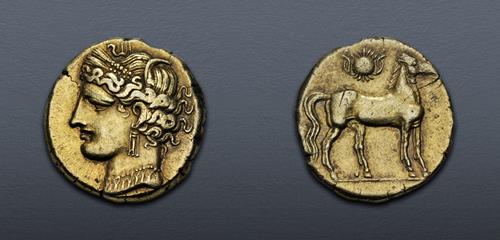
|
CARTHAGE, First Punic War. Circa 264-241 BC. EL 1½ Shekels – Tridrachm (21mm, 10.34 g, 12h). Carthage mint. Good VF.
Triton XXVII
Lot: 112. Estimated: $ 3 000
Greek, 12h, Coin-in-Hand Video, Electrum
Sold For $ 4 250. This amount does not include the buyer’s fee.
Go to Live
|
|
CARTHAGE, First Punic War. Circa 264-241 BC. EL 1½ Shekels – Tridrachm (21mm, 10.34 g, 12h). Carthage mint. Head of Tanit left, wearing wreath of grain ears with pellet on its leaf, triple-pendant earring, and necklace with nine pendants / Horse standing right, head left; ouraios above; pellet behind forward hind hoof. Jenkins & Lewis Group Xb, 428; CNP 41i; MAA 32; SNG Copenhagen 996; Bement 600; Jameson 923; de Luynes 3747–8; Weber 8491. Flan crack, trace deposits, scrape on edge. Good VF.
Carthage, a Phoenician colony on the coast of North Africa, became a maritime powerhouse in the fifth century BC and challenged the Greek cities of Sicily and Southern Italy for control of the western Mediterranean. By the early third century, much of Sicily had fallen under Carthaginian control and mints were established on the island to produce coins used to pay the largely mercenary army. The stage was now set for the collision with Rome, newly dominant in Italy. Starting in 265 BC, Carthage and Rome fought three titanic wars that produced more death and destruction than any other conflict before the 20th century. This electrum piece, struck at the mother city of Carthage, was produced early in the First Punic War with Rome, which raged for more than 20 years and ended with a humiliating defeat for Carthage and the loss of Sicily to the Romans. Still, Carthage’s empire remained otherwise intact and the loss only laid the groundwork for the similarly destructive Second Punic War. The use of electrum points to the need to stretch Carthage’s gold supply while striking a coinage that would have special appeal to the mercenary soldiers that made up most of its army. A head of the Phoenician goddess Tanit adorns the obverse, while the “Punic horse” symbolic of Carthaginian cavalry stands on the reverse.
The final winners of all Triton XXVII lots will be determined at the live public sale that will be held on 9-10 January 2024.
Triton XXVII – Session One – Lot 1-337 will be held Tuesday morning, 9 January 2024 beginning at 9:00 AM ET.
Winning bids are subject to a 22.5% buyer's fee for bids placed on this website and 25% for all others.
We recognize that our users may have various Internet Browsers and Operating Systems. We like our visitors to have the best possible experience when using our bidding platform. However, we do recognize that it is impossible to develop applications that work identically, efficiently and effectively on all web browsers. The CNG bidding platform supports the latest stable major version and stable previous version of Chrome and Firefox.
|
